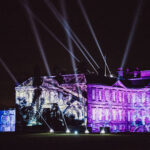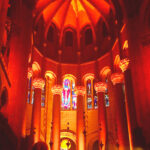Manufacturing an award-winning automobile involves the talents of a multitude of designers, engineers, artisans, and technicians. It requires an equally unique mix of talented people and companies to present that vision in the best possible light onto the show room floor. This year at the 2016 North American International Auto Show (NAIAS) in Detroit, Fiat Chrysler Automobiles (FCA) demonstrated just how far that vision could go. “Let’s put the show back in the auto show,” were the marching orders from FCA. Their vision led to perhaps the largest pixel count on any show ever, totaling 30 million.

A record-setting 1,200 DMX universes for this type of setting fed over 3,000 LED tiles in the space. George P. Johnson Experience Marketing (GPJ), long-time partner to FCA, built an impressive event space based around a concept of circular video columns surrounded by concentric rings.
GPJ invented the concept of experiential marketing nearly 100 years ago. Well known in the auto show world, with a global presence, GPJ brought together a collaborative team including Seibo Inc., Spinifex Group, James Klein Events (JKE), and a cadre of other A-list players.
It was very evident on the auto show floor that there was a lot of interest, not only from the public, but from the other brands as well.
 The Players
The Players
Full-service production company Seibo (founded in 2003 by CEO David Oberman) was tasked with providing all the technological gear for the booth. A team from JKE designed the control system and handled the programming of the stand. Spinifex Group designed the show itself and delivered all media content. The 60,000 square-foot booth highlighted a twofold dynamic of traditional auto show glamour and rock ‘n’ roll power.
Clay Brakeley, project manager with Seibo, served as technical director and production manager onsite. Primarily tasked with the planning and deployment of the technical equipment elements in a practical and cost effective way, he worked intimately with GPJ. Brakeley brought together subcontractors Rigging Dynamics of Long Beach, NY and Christie Lites to provide structural engineering, rigging, lighting, and power for the booth.

Through Seibo, Clay also sub contracted two companies to supply the video product throughout the space. LMG – headquartered in Orlando, FL and Boston-based Gateway. Says Brakeley, “for the new build, FCA wanted big, impressive, circular elements with multiple LED screens and surfaces that could be blended into a larger show.” GPJ designed and built the 40-foot circumference headers that capped the 25-foot tall circular column set pieces.
GPJ contracted Litestructures, a U.K. company, to construct the 18 rolled aluminum extrusion rings that formed much of the ceiling of the booth. Litestructures specializes in design and manufacture of complex aluminum fabrications. Global firm Mott McDonald engineered the pieces.

Each ring had three tracks of LED tape attached; two RGB, and one white totaling 387,000 individual pixels. These rings, like the show itself, are named the “Gears.”
Lighting designer Chris “Woj” Wojcieszyn has collaborated with both GPJ and Seibo many years in the past. Seibo hired Woj’s company, Lighthaus, to light the FCA stand. With a very specific push toward the effective use of automation on this project, he specified a combination of Martin MAC 2000, Viper and Aura XB fixtures.
Notes Chris, “I was very happy with the overall look as the LED and MAC fixtures balanced well. The 1200-watt lamp worked great on the cars and did not get lost in the massive amount of LED products. It all melded together on a visual plane.”
The lighting focus team used the iPad remote feature available with the grandMA2 console. With this technology, “response to client updates is immediate and the need for maneuvering lifts around expensive vehicles is eliminated. The ability to walk 360 around the car is much more efficient,” the LD adds.
Spinifex Group is a sister agency to, and part of, GPJ’s parent company, Project: Worldwide. With headquarters in Los Angeles and offices in New York and Sydney, Australia, Spinifex specializes in immersive and interactive media experiences for audiences, working primarily in event spaces.

Says executive producer Anthony Hickson, “I liken Spinifex to a creative studio, digital agency and production company, all rolled into one, which means we not only invent great ideas, but we bring them to life, too, through strategy, concepting, design, animation, production, post-production, development, technical integration and onsite installation.”
The company, as content deliverer and storyteller for the show, worked closely with GPJ and the FCA global creative team to bring the LED canvas to life. This meant extending content throughout the space as well as creating key moments that took advantage of the surround nature of the screens. Media management and file size created some challenges for Hickson’s team. A continuous flow of information had the company creating content right up to a few days before the show opened, the majority of which came from the Sydney studio.
“That in itself wasn’t the challenge,” says Hickson. “It was the logistics of transferring terabytes (Tb) and terabytes of content across the globe as quickly as possible.” To accomplish this, he established an offsite office in a local Detroit hotel, where the team worked around the clock to upload and download over 2Tb of material.
Earlier in 2015, Spinifex had worked on the FCA Dealer Announcement Show, a massive theatrical event that FCA puts on for their global dealers every three years. During the project, Hickson met and worked with the James Klein Events Company, which specializes in high-level technical production, production design, and event management. The company works across a wide range of concert, live broadcast, corporate, and high-end events.

The Layers
Each area within video, lighting and audio has a huge infrastructure. The main d3 4×4 Pro media servers required 32 outputs to control more than 600 gigabytes of visual content seen on the stand. Peter Vincent Acken accessed the servers via grandMA2 consoles. Hippo Taiga V4 servers were added to the mix as well, mapping content to the rings.
To help the team achieve FCA’s unique creative goal, several technological firsts occurred. Eighty ProPlex DMX 16-way distribution boxes were installed to control the FCA lighting rings. This was the first worldwide use of the units, which were marked with serial numbers 1-80. These distribution boxes included custom firmware designed and written specifically to meet the FCA projects needs.
Due to the sheer quantity of DMX universes needing control, the Hippo Control system running the content and effect on the rings is operating on custom modified versions of the Hippo Zookeeper operating system.
“James Klein is a world class technical director,” says Hickson, “and we thoroughly enjoyed working with his team on the FCA Dealer Announcement Show. Given the ambitious nature of the NAIAS opportunity, we were quite vocal about having JKE on board to help deliver it.”
As the technical production partner, James Klein Events oversaw the production server control, technical direction, system design and programming of the theatrical show. Klein’s responsibilities included design and installation of the server systems to control the LED video screens and the lighting rings.
Due to the scope of the FCA booth — a 60,000 square-foot space featuring seven brands and 20 separate LED screens that all needed to play in a synchronized manner — pre-visualization was crucial to the delivery of the show. JKE provided pre-visualization of the entire project and the programming team. He and his team modeled the entire stand in 3D, capturing all 32 outputs of d3 mapped across the LED screens in the model — which included a total of more than 700 moving lights, all 64 cars and the 387,000 pixels for the Lighting Rings.
JKE also oversaw the programming and show design of lighting, audio and video systems. The team was responsible for the LED ring content and lighting programming as well.
Adding 43 Martin Viper AirFX fixtures to the lighting system, JKE then integrated Lighthaus’ lighting rig into control with the video for the overall booth. Using two grandMA2 consoles, lighting directors Alex Grierson and Richard Neville of Mandylights performed the programming for the 700 fixtures in the grid and all the lighting rings. This amounted to 1,200 DMX universes, a record-setting size for this type of network.
One of the many innovative and unique aspects of the visualization system is that it is based around a real-time 3D stage simulator. It is the single solution needed to design, present, communicate, sequence and playback a show.
Klein points out, “d3 was chosen, as there were 30 million pixels of LED video screen surface that needed to be controlled. We ended up with 32 outputs from d3. That is a huge amount of processing power to control this amount of screen surface. The power of the new 4×4 pro machines allowed for playback to be perfect.”
The world’s first integrated video production suite, d3 is more than just a media server. d3 is designed to let users work with props, venues, LED screens, projection, lighting and moving stage elements, while being completely integrated into a single software solution that runs either on a laptop or dedicated d3 hardware.
“The JKE pre-viz tool allowed us to build the entire show, including content, lighting and audio cues, in advance of the physical booth being complete,” notes Hickson. “This was critical, given the complexity of the show,” he adds, citing the need to manage more than 200 individual video files and thousands of programming cues.
Although the crew had access to the booth early in December, it was not properly show-ready until the first week of January. Klein and Hickson were able to work independently of this schedule, so that when full access to the space finally occurred, the show was 90 percent programmed.
The JKE Pre-Viz functionality includes the ability to fly a virtual camera around any part of the booth to view the show from different vantage points in the virtual realm. That proved invaluable, Hickson notes, because clients could review the booth as the visuals were being developed. “This helped inform a number of key design decisions that would otherwise not have been possible until all the content was played at scale,” he says.
 A Three-Part Show
A Three-Part Show
The show was broken into three parts. The portion dubbed “Superstorm” begins the show. “Relief State,” a passive three-minute loop offering a bit of calm, follows the intensity of the Superstorm. The third part of the show, “Storm Cell,” is a three-minute full-screen takeover for each brand, each running one after another. Each of these takeovers features synchronized lighting and sound throughout the booth. At the end of the 20-minute show, the more traditional static white lighting, known as the “downstate,” encompasses the booth.
Audio design and playback came from d3 as well. The audio needed to play across the entire stand during the 20-minute theatrical portion. Once the booth took on the traditional auto show look, the audio individually highlighted each brand. This required 16 tracks of audio from multiple d3 4×2 servers running simultaneously for 40 minutes each hour. Audio time code generated the backbone controlling the whole booth. The show ran every hour on the hour. The cued music further enhanced the story, with different genres highlighting different brands.
JKE turned to Michigan-based Sound Reality Corporation (SRC) to handle audio programming for the booth. “I wanted to focus people’s attention and engage the consumers in the stand,” says Klein. “I tasked Michael, our A1, with manipulating the audio so that the audience felt surrounded by sound.”
Fifty Meyer UPJ loudspeakers and 20 Meyer USW subs were positioned around the booth. The TiMax Soundhub 3D audio matrix dynamic show control capabilities also added an elaborate animated soundscape to the space.“We used TiMax to create audio motion as well as focus on brands, and the entire booth, for any part of the one-hour show that was running for the duration of the exhibition,” explains Michael McDermott. “The spatial panning feature is simple and easy to integrate into an existing system.”
There was enough going on, visually, within the booth to provide plenty of surprises, even for repeat visitors. “A person can stand in different areas, or look in different directions of the booth and experience a totally new perspective of the show visually and aurally,” observes Hickson. “FCA deserves a lot of credit. It was ultimately their vision that started us thinking about this. The public viewing audience has never seen something like this at an auto show — it is a first,” he adds. “The usual order of business is dynamic press events for the first few days then the static look lighting the cars takes over. They wanted a more theatrical approach.”
The array of talent, experience and coordination synchronizing video, lighting, audio elements across the booth. “FCA really has introduced a whole new level of engagement to the industry,” Klein concludes.
CREW
Production Companies:
- George P Johnson: www.gpj.com
- Seibo Inc: www.seibo.com
- Spinifex Group: www.spinifex.group.com
- James Klein Events:www.jameskleinevents.com
- Rigging Dynamics: www.riggingdynamics.com
- Christie Lites: www.christielites.com
- LMG: www.lmg.com
- Gateway: www.gateway-productions.com
- Litestructures: www.litestructures.com
- Mott McDonald: www.mottmac.com
- Lighthaus: Chris “Woj” Wojcieszyn (Contact via Facebook/LinkedIn)
- Sound Reality Corporation: Michael McDermott (Contact via Facebook/LinkedIn)
GPJ Team
- Paul Hemsworth, Executive Creative Director
- Andrew Bourdon, Senior Creative Director
- Rich Cordova, VP Production
- John Tulloch, SVP EP
Seibo Team
- Clay Brakeley, Project Manager/TD
- Tracy Royan, Production Support
- Chris “Woj” Wojcieszyn, Lighting Designer
- Kevin Cassidy, Lighting Crew Chief
- Colin Beilstein, Technical Director, LED
- Bruce Spillman, Asst. Crew Chief/ Design and Focus
- Josh Rahalski, Asst. Crew Chief, Lighting and LED
- Cole McDonald, Systems Technician
- Wayne Boehning, Lighting Technician
- Phil Leonard, Lighting Technician
- Kevin Waters, Lighting /LED Technician
- Wanda Alfaro, Lighting/LED Technician
- Brian Wallace, Lighting Technician
- Jim Mecsery, Lighting Technician
- Mike Loveday, Lighting Technician
- Joel Rodriguez, LMG LED Technician
- Kim Hampton, LED Technician
- Brady Lord, Gateway LED Technician
- Russel Whaley, Gateway LED Technician
- Owen Thomas, Audio Technician
- Renee Lilley, Audio Technician
- Rocco Battaglia, RD Rigger
- Mike Matthews, RD Rigger
- Swen Ringwald, RD Rigger
- Ancell Brown, RD Rigger
- Keith Silano, RD Rigger
- Chris Campagnia, RD Rigger
- Ricardo Castriota, RD Rigger
- Dan Maucelli, RD Rigger
Spinifex Team
- Anthony Hickson, Executive Producer
- Jesus De Francisco, Creative Director
- Jason French, Design Lead
- Will Skinner, Lead Animator / Compositor
- Chris Homsley, Project Manager
- Pepin Portingale, 3D Lead
- Nic Hunter, 3D
- Chris Zwar, Animator
- Tom Hauville, Animator
- Esther Chung, Animator
- Nic Cunningham, Animator
- Jonathan Penzer, Editor
- Fil Ruting, Editor
- Marcus Longfoot, Sound Design
- Cyril De Baecque, Media Producer
- Carolien Foley, Media Producer
JKE Team
- James Klein, Producer for Show design/ Technical Director for Show control systems
- Jason Rudolph, System Designer / Technical Manager
- Peter Vincent Acken, D3 Programmer
- Michael McDermott, Audio Engineering
- Richard Neville, Lighting programming show design
- Alex Grierson, Lighting programming show design
- Emery Martin, Media management and Lighting Rings System tech
- Kerstin Hovland, Media management and Animator Lighting Rings
- Joe Denham, server Technician
- David Perkins, Pre Visualization Technician
- Robert Montenegro, Animator Lighting Rings
- Josh Henderson, Lighting Rings System tech
- Courtney McDaniel, Lighting Rings System tech
- Ray McNally, Site Manager
GEAR
The Lighting Rings/Gears
- 2 grandMA2 for d3 programming
- 2 grandMA2 for Lighting
- 4 Hippo Taiga V4s with custom software
- 80 ProPlex IQ Two 1616 bidirectional DMX-Ethernet converters
- 400 Custom TMB Sneak Snake RJ45 3-way DMX converters
- 3 Proplex 1g managed switches
- 18 Cisco 102-24 1g switches
- 1 Distrpalizer for TC
- 100,000 Linear feet of custom-made cables
- 1200 DMX lighting universes of control (record setting size for this type of network)
- 387,000 Individual pixels of LED
- 5000 connections made for system wiring of the Lighting rings
Media Control
- 30 million pixels of video screen display
- 32 outputs of content from d3 4×4 Pro media content servers
- 16 individual outputs for audio allowing eight stereo tracks to be played back at once.
- Audio designed in a 3D environment to allow for surround tracking of sound to more than 50 speakers in the booth.
- 12 d3 Servers
- 2 Extron 36×36 DVI Router
- 1 Black Magic 72×72 HDSDI Router
- 24 Datapath X4
- 40 Cobalt HDSDI Da’s
- 2 Evertz 16 VIPS
- 2 Black Magic 16 VIPS
- 12 Cisco 102-24 Switches
- 4 Netgear 10g Switches
- 1 48Tb Nas Server
- 3 Pathfinders
- 2 Distripalizers for TC
- 1 Evertz 5600 Master Clock
- 2 Netgear 10g switches for content management
Lighting
- 5 grandMA2 consoles
- 43 Martin MAC Viper AirFX
- 42 Martin MAC Viper DX
- 30 Martin MAC Viper DX Performance
- 79 Martin MAC 2000 XB
- 373 Martin MAC 2000 fixtures
- 89 Martin MAC Aura
- 20 TC Luster LED Ellipsoidal
- 22 Static Pars
- 18 Ayrton MagicBlades
- 20 Clay Paky Sharpys
- TRUSS: Over 7800 feet of 12”, 16” 12” x 30”, and 14” x 24”
- Chain Hoists: 406 of 1/4T, 1/2T, 1T, 2T
LED and Audio
- 980 3.9mm Unilumin LED tiles (Hi res walls in each brand)
- 1485 5mm Gateway flex LED tiles on columns
- 896 8mm Omni LED tiles on Halos
- 155 18mm WinVision LED tiles: Fiat Chandelier
- 50 UPJ-1P Meyer full range speakers
- 20 UMS-1P Meyer subs
- 1 Yamaha CL-5 Console
- 1 Yamaha DM200 Console
- 8 Shure Breakout Wireless Combo kits


